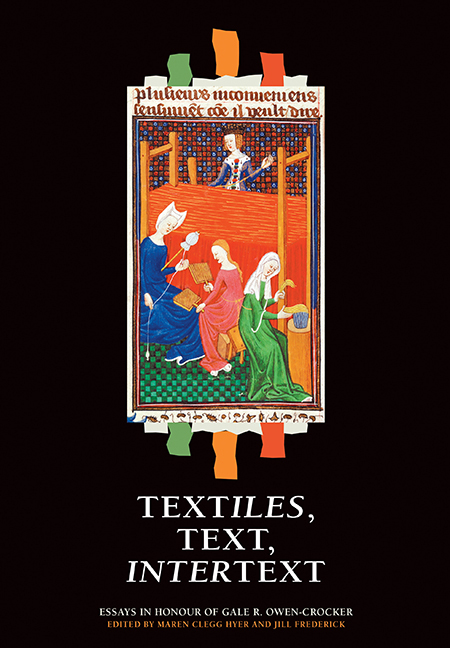14 results
Part III - Intertext
-
- Book:
- Textiles, Text, Intertext
- Published by:
- Boydell & Brewer
- Published online:
- 05 July 2016
- Print publication:
- 18 March 2016, pp 181-182
-
- Chapter
- Export citation
Frontmatter
-
- Book:
- Textiles, Text, Intertext
- Published by:
- Boydell & Brewer
- Published online:
- 05 July 2016
- Print publication:
- 18 March 2016, pp i-iv
-
- Chapter
- Export citation
Index
-
- Book:
- Textiles, Text, Intertext
- Published by:
- Boydell & Brewer
- Published online:
- 05 July 2016
- Print publication:
- 18 March 2016, pp 255-264
-
- Chapter
- Export citation
List of Abbreviations
-
- Book:
- Textiles, Text, Intertext
- Published by:
- Boydell & Brewer
- Published online:
- 05 July 2016
- Print publication:
- 18 March 2016, pp viii-viii
-
- Chapter
- Export citation
List of publications of Gale R. Owen Crocker
-
- Book:
- Textiles, Text, Intertext
- Published by:
- Boydell & Brewer
- Published online:
- 05 July 2016
- Print publication:
- 18 March 2016, pp 17-24
-
- Chapter
- Export citation
Part I - Textile
-
- Book:
- Textiles, Text, Intertext
- Published by:
- Boydell & Brewer
- Published online:
- 05 July 2016
- Print publication:
- 18 March 2016, pp 25-26
-
- Chapter
- Export citation
Tabula Gratulatoria
-
- Book:
- Textiles, Text, Intertext
- Published by:
- Boydell & Brewer
- Published online:
- 05 July 2016
- Print publication:
- 18 March 2016, pp 265-265
-
- Chapter
- Export citation

Textiles, Text, Intertext
- Essays in Honour of Gale R. Owen-Crocker
-
- Published by:
- Boydell & Brewer
- Published online:
- 05 July 2016
- Print publication:
- 18 March 2016
Contents
-
- Book:
- Textiles, Text, Intertext
- Published by:
- Boydell & Brewer
- Published online:
- 05 July 2016
- Print publication:
- 18 March 2016, pp v-vi
-
- Chapter
- Export citation
List of Illustrations
-
- Book:
- Textiles, Text, Intertext
- Published by:
- Boydell & Brewer
- Published online:
- 05 July 2016
- Print publication:
- 18 March 2016, pp vii-vii
-
- Chapter
- Export citation
Part II - Text
-
- Book:
- Textiles, Text, Intertext
- Published by:
- Boydell & Brewer
- Published online:
- 05 July 2016
- Print publication:
- 18 March 2016, pp 119-120
-
- Chapter
- Export citation
3 - The nature of Old English verse
-
-
- Book:
- The Cambridge Companion to Old English Literature
- Published online:
- 05 May 2013
- Print publication:
- 02 May 2013, pp 50-65
-
- Chapter
- Export citation
Contributors
-
-
- Book:
- The Cambridge Companion to Old English Literature
- Published online:
- 05 May 2013
- Print publication:
- 02 May 2013, pp vii-viii
-
- Chapter
- Export citation
3 - The nature of Old English verse
-
-
- Book:
- The Cambridge Companion to Old English Literature
- Published online:
- 28 May 2006
- Print publication:
- 31 May 1991, pp 55-70
-
- Chapter
- Export citation

